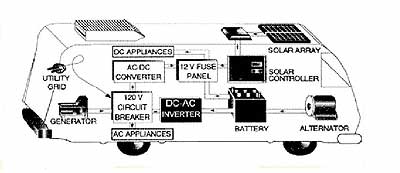As you add more electric powered creature comforts to your RV, you eventually reach the capacity of your electrical system. You can add more batteries or a generator. Another solution is solar power. Solar generated electricity is clean, quiet, environmentally friendly and free, that is once you have paid for the equipment and installation. Solar power systems are now available that range in size and capability from "trickle chargers" to keep batteries charged while parked in storage to systems sufficient power to run everything in a well equipped RV.

Electricity is produced when sunlight strikes the solar or photovoltaic cell. Voltage depends on the type of semiconductor material used, whereas the cell area and the intensity of the light determine the amperage of the current. By connecting together a sufficient number of individual PV cells, you can obtain the voltage, amperage and wattage needed, within reason. While brilliant sunlight is of best, they will work on cloudy days but with reduced output. Indeed, the PV will supply partial power in as little as 5 to 10-percent sunlight. Fortunately, the U.S. is blessed with lots of sunshine anywhere from 4 to 6 hours of annually averaged peak sun hours per day in most areas of the country. .
If you want energy when the sun goes down, part of the energy will have to be stored in batteries connected to the solar module. A charge controller or regulator can be added to prevent over-charging. Many smaller systems use self-regulating solar modules in lieu of a charge controller. More complex systems might also include meters to monitor system operation and fuses for protection. While this simple system will power DC items,you will need an DC to AC inverter if you want to power AC appliances. .
Choosing the right battery system is important. Special "deep-cycle" batteries are much better than ordinary automotive batteries for solar power systems. Deep cycle batteries can be repeatedly discharged and recharged, that is "cycled", and the discharge can be to a very low level, thus the "deep" terminology. By contrast, automotive batteries are primarily designed to supply a powerful, but short bursts of electrical energy to get the car started. Then the alternator takes over and recharges the battery as well meeting electrical needs when the car is running down the road. Deep cycling, that is almost completely discharging the automotive battery will result in a much shorter lifetime or even a premature failure for automotive-type batteries. .
When choosing the battery, it must have enough ampere-hour capacity to provide the required power until there is enough sunlight to recharge the battery and do it without exceeding the maximum desired depth of discharge. Usually the ampere-hour capacity is specified along with a standard hour reference, typically ten or twenty hours. If the specs say the battery is rated at 80 ampere-hours with a 10 hour reference, it means the fully charged battery will provide 8-amperes for 10 hours. If the current drain is greater, the time will decrease.
To determine the size of a system needed, first, pick an average day and list the DC lighting and appliances you would use and how many hours a day they are typically on. You can read the specification plates on appliances to determine the Watts they use. If only the amperage is given, then multiply this by 12 volts to obtain the Watts consumed. If there are no specs available, this can help in making rough estimates.
| APPLIANCE | POWER DEMAND (Watts per hour) |
| Cassette Player | 30 |
| CB Radio | 12 |
| Fan - Ceiling | 25 |
| Fan - Furnace | 48 |
| Lamp - Incandescent | 25-75 |
| Lamp - Flourescent | 20 |
| Refrigerator | 60 |
| Television - 9" color | 48 |
| Water Pump - Circulating | 32 |
Next, if you have AC appliances, repeat the process, except now multiply amperes by 120 volts to determine Wattage. For AC appliances without tags, this can be used for estimates.
| APPLIANCE | POWER DEMAND
(Watts per hour) |
| Coffee Maker | 375-550 |
| Lamp - Incandescent | 75-100 |
| Microwave Oven | 300-1000 |
| Radio | 75 |
| Refrigerator - 12 cu. ft. | 350 |
| Television - 19" color | 175 |
| Toaster | 1100-1250 |
Add up the total Watt-hours used to arrive at the total daily energy budget. Individual solar modules are available that provide from around 5 to 60 Watts. Multiply this by the number of hours of sunlight you can expect on an average to obtain the output of the module in terms of Watt-hours. Divide the total daily energy budget by the output of each module to determine the number of modules needed.
Finally, once you have solar modules installed it is important that the RV be parked so that it receives the maximum amount of direct sunlight during the prime sunlight hours of about 9 am to 3 pm. Even something as simple as the shadow from a utility pole can noticeably reduce the sunlight input to the solar cell. While panels are normally placed horizontally on the roof of a vehicle, tilting the panel towards the sun can improve the efficiency. The amount of tilt depends on your latitude. The angle of tilt is measured from the horizontal and the panels should face south.
| LATITUDE [degrees] | TILT ANGLES [degrees] |
| 0 to 15 | 15 |
| 15 to 25 | angle is same as latitude |
| 25 to 30 | latitude + 5 |
| 30 to 35 | latitude + 10 |
| 35 to 40 . | latitude + 15 |
| above 40 | latitude + 20 |




